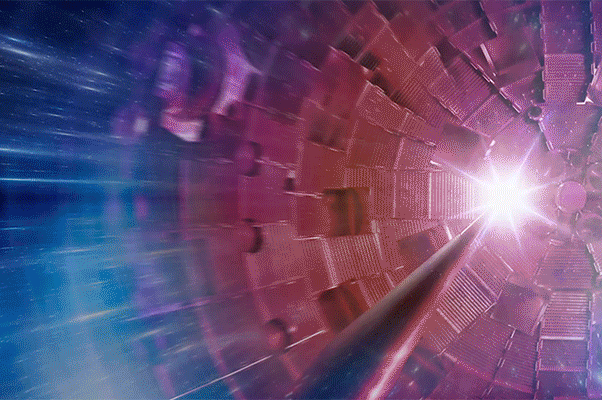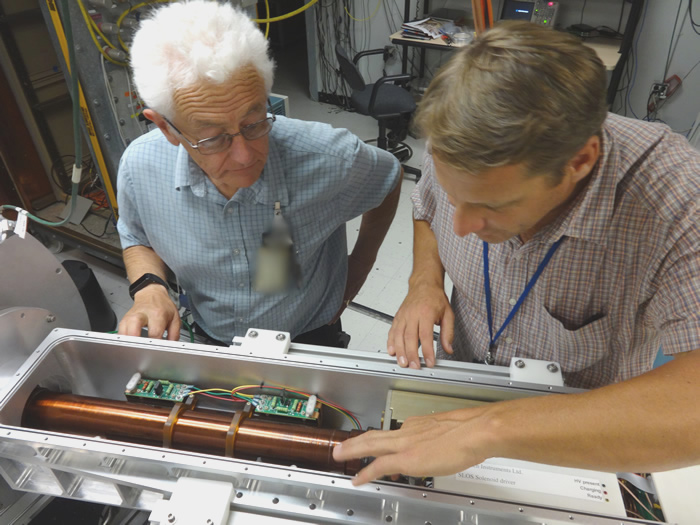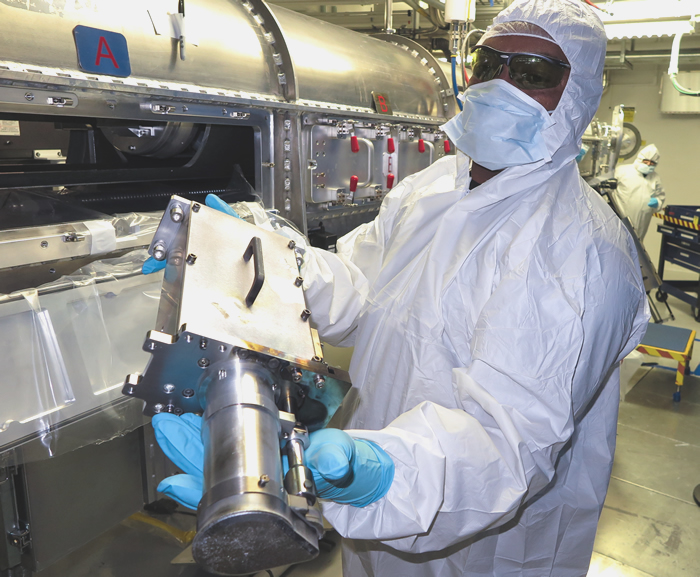NIF Diagnostics Played Key Role
in Fusion Milestone
November 8, 2021
Third in a series of articles describing aspects of the National Ignition Facility’s record-breaking 1.3-megajoule experiment.
Part 1: “Building to a Solution: The Elements of a Fusion Breakthrough”
Part 2: “‘Hybrid’ Experiments Drive NIF Toward Ignition”
Part 4: “High-Quality Diamond Capsule Enhanced NIF’s Record-Energy Shot”
Part 5: “Laser Improvements Contributed to Record Fusion Experiment”
Part 6: “Models and Simulations Help Map NIF’s Path to Ignition”
Part 7: “Milestone Shot Enhances Future of Stockpile Stewardship and Fusion Energy Science”
The National Ignition Facility (NIF)’s highly specialized and sophisticated measuring instruments known as diagnostics were integral to the record-setting inertial confinement fusion (ICF) experiment that produced more than 1.3 million joules (MJ) of fusion energy.

In another important milestone, the Aug. 8, 2021, breakthrough on NIF, the world’s largest and highest-energy laser system, marked the culmination of a series of advances in diagnostics dating back to the mid-1990s. The achievement represented contributions over the years from the entire high energy density (HED) science community and the support of all NIF users.
“It takes a village—most definitely,” said Andrew MacKinnon, the lead scientist for NIF diagnostics, during a briefing on the 1.3-MJ experiment. “These are among the most well-diagnosed experiments in the field of HED science,” he said, crediting the recent series of advancements with playing a key role in reaching the 1.3-MJ milestone.
The advances have brought researchers to the threshold of the National Academy of Sciences’ formal definition of ignition: a NIF implosion that produces as much or more fusion energy than the amount of laser energy delivered to the target. NIF fires 192 high-energy lasers into a fusion target the size of a pencil eraser and is capable of producing temperatures of more than 100 million degrees Kelvin and pressures of hundreds of billions of Earth atmospheres (see “How NIF Targets Work”).
The NIF diagnostic suite dissects all aspects of the experiment, enabling researchers to develop a physical understanding of what is actually occurring that can be compared to models and used to inform future experimental designs. The diagnostics provide detailed information on how much laser energy is delivered and coupled to the target, how uniformly the capsule is compressed, how well the implosion performs, and how much fusion energy is released by the compressed capsule.
 Members of the NIF Nuclear Diagnostics Team (from left): Eddie Mariscal, Richard Bionta, Petr Volegov, Thomas Murphy, Valerie Fatherley, Kelly Hahn, Ed Hartouni, Joe Kilkenny, Dave Schlossberg, Andrew Mackinnon, Alastair Moore, Shaun Kerr, David Fittinghoff, Jorge Carrera, Joseph Caggiano, Justin Jeet, and Wenhai Yang. Credit: Jason Laurea
Members of the NIF Nuclear Diagnostics Team (from left): Eddie Mariscal, Richard Bionta, Petr Volegov, Thomas Murphy, Valerie Fatherley, Kelly Hahn, Ed Hartouni, Joe Kilkenny, Dave Schlossberg, Andrew Mackinnon, Alastair Moore, Shaun Kerr, David Fittinghoff, Jorge Carrera, Joseph Caggiano, Justin Jeet, and Wenhai Yang. Credit: Jason Laurea These diagnostics have enabled new measurement capabilities that have increased understanding of degradations to ICF implosions such as asymmetries, mixing of capsule material in the hot spot, and fuel and capsule thickness variations, and have helped to develop mitigations.
“Diagnostics are an important measurer of integrated performance,” said ICF Chief Scientist Omar Hurricane. “That includes not only what we thought the design would do, but also the impact of the targets and, in particular, any imperfections in the target and in the laser and the laser delivery, if that happens.”
Scientific Diagnostic Leader Joe Kilkenny, who has led the NIF diagnostics team for a decade, likened the role of the facility’s diagnostics to those used in cars. While NIF has five times more diagnostics than cars, both types come in two broad categories—performance optimization, and identification of issues.
The first category allows fine-tuning on expected performance, Kilkenny said. A car’s fuel, throttle, and knock sensors allow precision in timing the ignition of the fuel. On NIF, high precision in implosion symmetry and adiabat (fuel compressibility) control is achieved by monitoring and correcting the shape of the implosion and by timing the series of small shocks that compress the fuel.
The second category monitors system performance and provides notification of unexpected occurrences, according to Kilkenny. Diagnostics on a car can trigger emergency braking or suggest attending to the cooling system. NIF diagnostics can warn of imperfections in the target or the laser that require mitigation.
 Joe Kilkenny, left, and Terry Hilsabeck of General Atomics examine the drift tube in NIF’s groundbreaking Single Line of Sight (SLOS) framing camera. The drift tube is analogous to the slow-motion feature on a standard camera. Credit: Kenneth Piston
Joe Kilkenny, left, and Terry Hilsabeck of General Atomics examine the drift tube in NIF’s groundbreaking Single Line of Sight (SLOS) framing camera. The drift tube is analogous to the slow-motion feature on a standard camera. Credit: Kenneth Piston Data from NIF’s suite of state-of-the-art nuclear, x-ray, and optical diagnostics were used to scrutinize the more than 170 ignition experiments conducted since 2011. The data were analyzed to provide vital insights, build understanding in all stages of the ICF implosions, and inform the computer models and simulations that helped guide the design of future experiments.
One important diagnostic is the 3D neutron imaging system (NIS), developed by researchers at Los Alamos National Laboratory (LANL) in collaboration with Lawrence Livermore National Laboratory (LLNL) colleagues. NIS data is used to provide a 3D analysis of the neutron-emitting hot spot and the surrounding deuterium-tritium fuel, an important measure of the quality of the implosion.
 Target Area Operator Bill Board removes the neutron imager snout from a diagnostic instrument manipulator. The NIF neutron imaging system (NIS) produces an image of the source distribution of high-energy, or primary, neutrons and lower-energy “down-scattered” neutrons produced by fusion reactions in a NIF implosion. This enables researchers to determine hot-spot size and fuel asymmetry and to infer the cold-fuel areal density, a measure of the combined thickness and density of the fuel shell. Credit: James Pryatel
Target Area Operator Bill Board removes the neutron imager snout from a diagnostic instrument manipulator. The NIF neutron imaging system (NIS) produces an image of the source distribution of high-energy, or primary, neutrons and lower-energy “down-scattered” neutrons produced by fusion reactions in a NIF implosion. This enables researchers to determine hot-spot size and fuel asymmetry and to infer the cold-fuel areal density, a measure of the combined thickness and density of the fuel shell. Credit: James Pryatel About 20 diagnostics were used in the 1.35-MJ shot, including time-integrated and time-resolved x-ray imaging from three different lines of sight; time-integrated neutron imaging from three lines of sight; neutron spectra measurements from six lines of sight; absolute neutron yield via nuclear activation measurements; 48 real-time nuclear activation detectors that are used to infer DT fuel uniformity; and time-resolved x-ray and neutron emission and soft x-ray measurements from the hohlraum.
The researchers said all diagnostics performed well on the experiment, but noted that in the future, some instruments not used on high-yield shots will be removed from the target area to prevent sensor degradation. Meanwhile LLNL researchers and their colleagues continue to develop new diagnostics that are capable of operating in the presence of high-energy neutrons. Measuring the time evolution of ion temperature and electron temperature during ICF implosions are other high-priority goals for additional diagnostics.
Plans for the NIF diagnostic suite began in the mid-1990s, building on diagnostic expertise that originated at the Nevada Test Site and was then further developed at LLNL’s NOVA laser, NIF’s predecessor. In 2013, a new multi-laboratory diagnostic collaboration called the National Diagnostic Working Group was established. Its goal was to continue developing state-of-the-art diagnostics for all the HED laboratories funded by the National Nuclear Security Administration (NNSA).
NIF now has more than 120 diagnostics directly funded over the last decade by NNSA. Many key R&D elements of these diagnostic have also been supported by funding from Laboratory Directed Research and Development (LDRD) programs at LLNL and other NNSA laboratories.
The diagnostics, which are used for a wide variety of HED experiments, have benefited from decades of experience and ongoing collaborations with national and international partners, including LANL, Sandia National Laboratories, the University of Rochester’s Laboratory for Laser Energetics, the Massachusetts Institute of Technology, UC Berkeley, General Atomics, the Nevada National Security Site, National Security Technologies, LLC, and the atomic energy agencies in the U.K. and France.
More Information:
“Diagnostics Reveal the Details of NIF Experiments”
“NIF Implosions Shown to Have Significant 3D Asymmetries,” NIF & Photon Science News, August 27, 2020
“Nuclear Diagnostics Help Pave the Way to Ignition on NIF,” NIF & Photon Science News, March 6, 2020
“Discovery Science Inspires Novel Diagnostics for NIF,” NIF & Photon Science News, December, 2018
—Jon Kawamoto
Follow us on Twitter: @lasers_llnl



